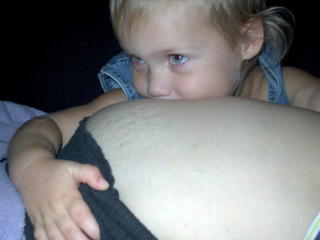I'm feeling the baby more and more! So exciting!From American Baby:
Your BabyChances are you'll have a mid-pregnancy ultrasound (also called a sonogram) between weeks 18 and 22 to monitor fetal development. Be sure to bring your partner along--you'll both be amazed as your little one kicks, boxes, and even somersaults for the camera. Based on the baby's size, your doctor or midwife will be able to confirm or adjust your due date. Plus, you'll get photographic printouts to take home for friends and family. Save a couple for the baby book--these fuzzy, black-and-white snapshots are your child's very first baby pictures!
From BabyCenter:
How your baby's growing: Your baby weighs about 8 1/2 ounces
(*woohoo, my baby boy is 10oz! hehehe*), and he measures 6 inches, head to bottom — about the length of a small zucchini. His arms and legs are in the right proportions to each other and the rest of his body now. His kidneys continue to make urine, and the hair on his scalp is sprouting. This is a crucial time for sensory development: Your baby's brain is designating specialized areas for smell, taste, hearing, vision, and touch. If your baby is a girl, she has an astonishing six million eggs in her ovaries. They'll dwindle to fewer than two million by the time she's born.
• Note: Experts say every baby develops differently — even in the womb. This developmental information is designed to give you a general idea of how your baby is growing.
How your life's changing: You're just a week shy of the halfway mark. You may notice some achiness in your lower abdomen (perhaps extending to your groin) or even a quick, sharp, stabbing pain on one or both sides, especially when you change position or at the end of an active day. This is
round ligament pain, and it's caused by the stretching of the muscles and ligaments that support your growing uterus. It's nothing to be alarmed about, but if the pain continues even when you're resting or becomes persistent and severe, call your practitioner.
You may also have noticed some skin changes lately. Are the palms of your hands red? Nothing to worry about — it's from increased estrogen. Patches of darkened skin are also common during pregnancy. When they show up around your upper lip, upper cheeks and forehead, they're called
chloasma, or the "mask of pregnancy." You may see these splotches on your arms or other areas that have been exposed to the sun. Your nipples, freckles, scars, underarms, inner thighs, and vulva may also darken during pregnancy. That darkened line running from your belly button to your pubic bone is called the linea nigra, or "dark line." All of this darkening is due to a temporary increase in melanin, the substance that colors your hair, skin, and eyes. For most women, these darkened spots will fade shortly after delivery. In the meantime, protect yourself from the sun, which intensifies the pigment changes. Cover up, wear a brimmed hat, and use sunscreen when you're outdoors. And if you're self-conscious about your "mask," a little concealing makeup can work wonders.











